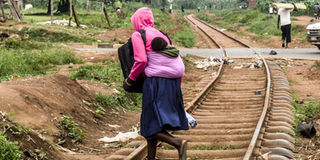Works on Tororo-Gulu railway line commence

A section of the railway line at Layibi near Gulu-Kampala highway. The rehabilitation works on the Gulu-Tororo railway line are expected to end in August 2022. PHOTO BY TOBBIAS JOLLY OWINY
What you need to know:
- In one of his nation addresses on Covid-19, President Museveni called for the revamping of the railway line to reduce the number of cargo trucks from neighbouring countries as a measure to contain the spread of Covid-19.
The rehabilitation works on the 375-kilometre Tororo-Gulu metre-gauge railway line have commenced, Daily Monitor has learnt.
The project, expected to cost about Euros 21.5 million (Shs90b), is scheduled to last until August 2022.
The Ministry of Works and Transport said the grant will account for the physical rehabilitation of the railway line, supervision of the construction works and capacity building of Uganda Railways Corporation that is executing the project.
It will also be used to compensate 4,000 project affected people, whose crops and building structures might be destroyed during the reconstruction.
Mr Emmanuel Gyezaho, the press adviser at the European Union (EU) confirmed the development on Monday.
“The EU is supporting the government of Uganda to revitalise railway transportation in northern Uganda, and is providing a grant of 21.5 million Euros for the rehabilitation works. The project is expected to reduce transport costs within [the region] and beyond,” Mr Gyezaho said.
“It is the same funding that was announced in 2018. The works are expected to go up to the end of 2022,” he added.
In October 2018, the EU and the Ugandan government signed the financing agreement for the grant to rehabilitate the 375km line that ceased operations nearly two decades ago. The railway line cuts across seven districts.
Mr Patrick Kinyera, the Gulu secretary for works, on Monday said the rehabilitation would boost economic development.
“This region is largely an agricultural producing region and transport has been the biggest hurdle to farmers but once we can have cheap and accessible transport alternatives, farmers will be able to move their produce to better markets at better pricing,” Mr Kinyera said.
Emphasised
In one of his nation addresses on Covid-19, President Museveni called for the revamping of the railway line to reduce the number of cargo trucks from neighbouring countries as a measure to contain the spread of Covid-19.
While visiting the project site recently, Mr Magbrit Holm Jakobsen, the head of mission at the Danish Embassy in Uganda, said the rehabilitated railway line will increase the movement of cargo.
“The movement of cargo by rail is better for the environment and the roads. It will be easier for traders to move bulk commodities, it is cheaper,” Mr Jakobsen said.
Trade link
Logistics hub. The railway line is also expected to complement the construction of Gulu logistics hub at Gulu Raliway Station, whose works started last month. The hub, which targets markets such as South Sudan through Alegu and DR Congo through West Nile, will cost $8.6m (Shs30.96b) of which $5.6m (Shs20b) is available with funding from DFID and Trade Mark East Africa. The hub is designed as a dry port with both rail and truck terminals. Cargo transportation into and out of the hub will be through roads by trucks as the railway line from Tororo to Gulu is rehabilitated.



